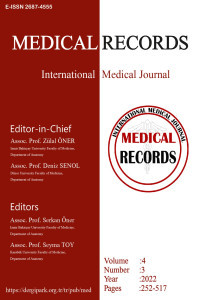The Effect of Mesh Fixation Methods on Pain Sensation After Laparoscopic Inguinal Hernia Repair
The Effect of Mesh Fixation Methods on Pain Sensation After Laparoscopic Inguinal Hernia Repair
Aim: Groin hernia repair is one of the most common surgical procedure in general surgery. The use of prosthetic meshs has reduced the recurrence rate after inguinal hernia repair to less than 5%. Chronic pain is thought to be multi-factorial. Among these, surgical-related factors are the types of mesh used and fixation methods. It was aimed to evaluate the effect of the use of absorbable and non-absorbable screws for mesh fixation on post-operative pain during TEP repair.
Material and Methods: The data of patients who were operated on by a single surgeon and who underwent TEP repair for unilateral or bilateral inguinal hernia were reviewed retrospectively. Post-operative first-week pain sensations were compared between patient groups in which absorbable and non-absorbable screws were used for patch fixation.
Results: A total of 35 patients who were operated by a single surgeon and who underwent laparoscopic total extraperitoneal (TEP) repair for unilateral or bilateral inguinal hernia were included in the study. It was found that patients in the absorbable screw group felt statistically significantly less pain [VAS: 3 (2-7) vs. 4 (2-8); p=0.03].
Conclusion: Chronic pain after patchy hernia repair is also seen as a late complication that can last up to 6 months. This study, which proves that the use of absorbable stabilizers leads to less pain in the early period, reveals that this method may also be a suitable method for preventing the development of possible chronic pain.
Keywords:
hernias, inguinal hernias, surgical mesh, surgical fixation, laparoscopy TEP repair,
___
- Bay-Nielsen M, Kehlet H, Strand L, et al. Quality assessment of 26,304 herniorrhaphies in Denmark: a prospective nationwide study. Lancet. 2001;358:1124-8.
- Awad SS, Fagan SP. Current approaches to inguinal hernia repair. Am J Surg. 2004;188:9S-16S.
- Sanders DL, Waydia S. A systematic review of randomised control trials assessing mesh fixation in open inguinal hernia repair. Hernia. 2014;18:165-76.
- Molegraaf M, Kaufmann R, Lange J. Comparison of self-gripping mesh and sutured mesh in open inguinal hernia repair: a meta-analysis of long-term results. Surgery. 2018;163:351-60.
- HerniaSurge Group. International guidelines for groin hernia management. Hernia. 2018;22:1-165.
- Andresen K, Rosenberg J. Management of chronic pain after hernia repair. J Pain Res. 2018;11:675-81.
- Burgmans JPJ, Voorbrood CEH, Simmermacher RKJ, et al. Long-term results of a randomized double-blinded prospective trial of a lightweight (Ultrapro) versus a heavyweight mesh (Prolene) in laparoscopic total extraperitoneal inguinal hernia repair (TULP-trial). Ann Surg. 2016;263:862-6.
- Lau H, Patil NG. Acute pain after endoscopic totally extraperitoneal (TEP) inguinal hernioplasty: multivariate analysis of predictive factors. Surg Endosc. 2004;18:92-6.
- Koch CA, Greenlee SM, Larson DR, et al. Randomized prospective study of totally extraperitoneal inguinal hernia repair: Fixation versus no fixation of mesh. JSLS. 2006;10:457-60.
- Kumar A, Kaistha S, Gangavatiker R. Non-fixation versus fixation of mesh in totally extraperitoneal repair of inguinal hernia: a comparative study. Indian J Surg. 2018;80:128-33.
- Sayadi Shahraki M, Mahmoudieh M, Keleidari B,et al. The effect of internal mesh fixation and external fixation (inguinal hernia truss) on postoperative complications in patients with inguinal hernia undergoing totally extraperitoneal laparoscopic hernioplasty. Adv Biomed Res. 2022;11:49.
- Novik B, Sandblom G, Ansorge C, Thorell A. Association of mesh and fixation options with reoperation risk after laparoscopic groin hernia surgery: a Swedish hernia registry study of 25,190 totally extraperitoneal and transabdominal preperitoneal repairs. J Am Coll Surg. 2022;234:311-25.
- Matikainen M, Aro E, Vironen J, et al. Factors predicting chronic pain after open inguinal hernia repair: a regression analysis of randomized trial comparing three different meshes with three fixation methods (FinnMesh study). Hernia. 2018;22:813-8.
- Alabi A, Haladu N, Scott NW, et al. Mesh fixation techniques for inguinal hernia repair: an overwiev of systematic reviews of randomised controlled trials. Hernia. 2022;26:973-87.
- Hirsch H, Nagatomo K, Gefen J. Mesh fixation with fibrin sealant in totally extraperitoneal hernia repair. J Laparoendosc Adv Surg Tech A. 2017;27:259-63.
- Sajid MS, Ladwa N, Kalra L et al. A meta-analysis examining the use of tacker fixation versus no-fixation of mesh in laparoscopic inguinal hernia repair. Int J Surg. 2012;10:224-31.
- Yayın Aralığı: Yılda 3 Sayı
- Başlangıç: 2019
- Yayıncı: Zülal ÖNER
Sayıdaki Diğer Makaleler
COVID 19 Hastalarında Arcus Aorta Açısı ve Arcus Aorta Morfometrisi: Radyoanatomik bir Çalışma
Rukiye ÇİFTÇİ, Hilal ER ULUBABA, Sibel ATEŞOĞLU KARABAŞ
İlteriş Ahmet ŞENTÜRK, Edip GÖNÜLLÜ
Five-Years Intensive Care Percutaneous Tracheostomy Results
Kubilay İŞSEVER, Ali MUHTAROĞLU, Furkan Ali UYGUR, Muhammet Burak KAMBUROGLU
Investigation of the Effect of Propolis on Penicillin Induced Epileptiform Activity in Rats
Tuba EKMEKYAPAR, Seval DEMİR AYDIN
Şeyma Banu ARSLANCA, İzzet ÖZGÜRLÜK, Tugba Kolomuc GAYRETLİ, Zeynep ŞEYHANLI, Şevki ÇELEN
Role of SARS-CoV2 Virus in the Etiology of Acute Pancreatitis
İlker KIZILOĞLU, Didem DERELİ AKDENİZ, Funda UĞUR KANTAR
